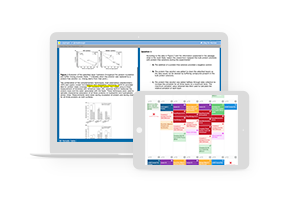Blueprint MCAT Blog: MCAT Question of the Day
Categories

Mar 20, 2015
MCAT Organic Chemistry Question — Alcohol Reactions
Considering all “-R” groups to be alkyl groups, which alcohol is most reactive in an SN1 reaction with HCl? a) primary alcohol b) secondary alcohol c) tertiary alcohol d) number of substituent groups does not affect alcohol reactivity READ MORE
Mar 19, 2015
MCAT Biology Question — Carbon Reactions
In the Felkin model, a carbon which is originally achiral can undergo a reaction to generate a single enantiomer with 98% yield (with the remaining 2% generating the opposite enantiomer). This type of reaction is best described as: A) Chiral chromatography B) Racemization C) Asymmetric induction D) Unimolecular elimination READ MORE
Mar 18, 2015
MCAT Biology – Germ Layers
The lining of the digestive tract and the respiratory tract develops from which germ layer? I. Endoderm II. Mesoderm III. Ectoderm a) I only b) II only c) III only d) I and II READ MORE
Mar 17, 2015
MCAT Physics – Light Behavior
A ray of light traveling through air hits a pane of glass with known refractive index. What information is required in order to calculate the angle of refraction? a) Planck’s constant and the speed of light b) the specific gravity of the glass c) the angle of incidence d) the density of air and the READ MORE
Mar 16, 2015
MCAT Physics – Doppler Effect
Radar guns used to detect the speed of motorists relies on the principles of sound and Doppler effect. All of the following measurements may be utilized to calculate the relative velocity of a motor vehicle EXCEPT: A. Speed of sound in air B. Period of the wave emitted C. Density of the air D. Frequency READ MORE
Mar 13, 2015
MCAT Psychology – Correlation
In the course of gathering data in an experiment, a researcher develops the following correlation matrix: Table 1 Correlation Matrix Which of the following pairs of variables are most strongly correlated? A) A, C B) A, D C) B, D D) C, D READ MORE
Mar 12, 2015
MCAT Physics – Sound Wave Behavior
A source emits a sound from one medium with a certain velocity, intensity, frequency and wavelength. When the sound exits the first medium and enters a denser medium, all of the following changes EXCEPT: A. velocity B. intensity C. frequency D. wavelength READ MORESearch the Blog

Free Consultation
Interested in our Online MCAT Course, One-on-One MCAT Tutoring or Med admissions packages? Set up a free consultation with one of our experienced Senior Student Advisors.
Schedule NowPopular Posts
-
MCAT Blog What's on the MCAT?
-
MCAT Blog How to Review MCAT Full Lengths

Free MCAT Practice Account
Need great MCAT practice?Get the most representative MCAT practice possible when you sign up for our free MCAT Account, which includes a half-length diagnostic exam and one of our full-length MCAT practice exams.
Learn More




